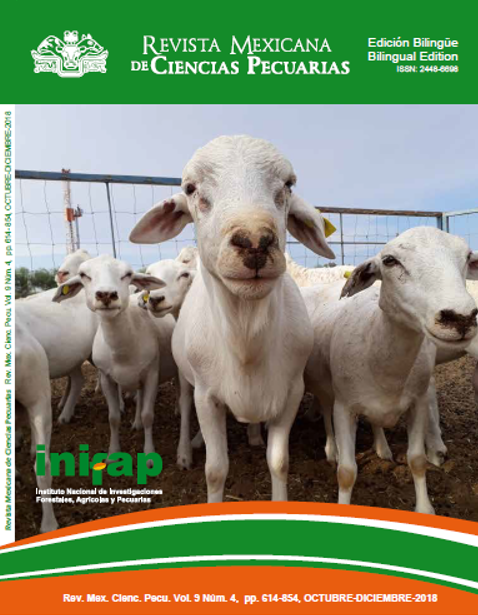Levels of fumonisins in corn stover for equine consumption in Jalisco State
DOI:
https://doi.org/10.22319/rmcp.v9i4.4651Keywords:
Fumonisins, Corn stover, Equine.Abstract
The objetive was to determine the presence and levels of fumonisins in feed from confirmed cases of equine leukoencephalomalacia from the Municipality of Juchitlán (Jalisco State). The field study included the 13 main municipalities where one of the biggest equine population in Jalisco is concentrated. They have a similar feeding management practices and feed preservation. The analytical determinations were performed by competitive type immunoassay and high-resolution liquid chromatography. Contamination with fumonisins was detected in 100 % of analyzed samples; levels were from 0.23 to 19.18 mg/kg. There was a difference between localities (P<0.001); the highest concentration was observed in Ahualulco de Mercado (mean: 12.83 mg/kg) and the lowest concentration in Concepción de Buenos Aires (mean: 0.27 mg/kg). Of the total samples analyzed, 62 % exceeded the recommended limit for horses.
Downloads
References
Gelderbrom WC, Marasas WFO, Vleggar R, Thiel PG, Cawood ME. Fumonisins: isolation, chemical characterisation and biological effects. Mycopathologia 1992;(117):11-16.
Deepa N, Sreenivasa MY. Fumonisins: A review on its global occurrence, epidemiology, toxicity and detection. J Vet Med Res 2017;4(6):1093-1102.
Marin P, Magan N, Vázquez C, González-Jaén MT. Differential effect of environmental conditions on the growth and regulation of the fumonisin biosythetic gene FUM1 in the maize producer Fusarium verticillioides and Fusarium proliferatum. Microbiol Ecol 2010;(73):303-311.
Alizadeh AM, Roshamdel G, Roudbarmohammadi S, Roudbary M, Sohanaki H, Ghiasian SA, et al. Fumonisin B1 contamination of cereals and risk of esophageal cancer in a high risk area in northeastern Iran. Asian Pacific J Cancer Prev 2012;(13):2625-2628.
IARC. International Agency for Research on Cancer. Some traditional herbal medicines, some mycotoxins, naphthalene and styrene. Monographs on the evaluation of carcinogenic risks to humans. Lyon 2002;(82):33.
Caloni F, Cortinovis C. Effects of fusariotoxins in the equine species. Vet J 2010;(186):157-161.
Vendruscolo CP, Frias NC, de Carvalho CB, de Sá LMR, Belli CB, Baccarin RYA. Leukoencephalomalacia outbreak in horses due to consumption of contaminated hay. J Vet Intern Med 2016;(30):1879-1881.
Ross PF, Rice LG, Reagor JC, Osweiler GD, Wilson TM, Nelson HA, et al. Fumonisin B1 concentrations in feeds from 45 confirmed equine leukoencephalomalacia cases. J Vet Diagn Invest 1991;(3):238-241.
Rosiles MR, Bautista J, Fuentes VO, Ross F. An outbreak of equine leukoencephalomalacia at Oaxaca, Mexico, associated with fumonisin B1. J Vet Med Series A 1998;45(5):299-302.
Giannitti F, Sain SD, Pacin AM, Barrandeguy M, Larrere C, Ortega J, Uzal FA. Equine leukoencephalomalacia (ELEM) due to fumonisins B1 and B2 in Argentina. Pesq Vet Bras 2011;31(5):407-412.
FDA, Food and Drug Administration, Center for Food and Applied Nutrition. Guidance for Industry. Fumonisin levels in human foods and animal feeds 2001. https://www.fda.gov/Food/GuidanceRegulation/GuidanceDocumentsRegulatoryInformation/ucm109231.htm
Arias S, Patricio SM, Theumer M, Rubinstein H, Reyes-Velázquez WP. Ocurrencia natural de fumonisinas en rastrojo de maíz procedente de diferentes variedades e híbridos en el estado de Jalisco [resumen]. Semana de la Investigación Científica, CUCBA. Universidad de Guadalajara 2010:146.
Shephard GC, Sydenham EW, Thiel PG, Gelderblom WCA. Quantitative determination of fumonisins B1 and B2 by high-performance liquid chromatography with fluorescence detection. J Liq Chromatogr 1990;(13):2077-2080.
Doko B, Rapior S, Visconti A, Schjoth J. Incidence and levels of fumonisins contamination in maize genotypes grown in Europe and Africa. J Agric Food Chem 1995;(43):429-434.
CONAGUA. Comisión Nacional del Agua. Servicio Meteorológico Nacional. Reporte Anual 2011 y 2012.
Sydenham EW, Marasas WFO, Shephard GS, Thiel PG, Hirooka EY. Fumonisin concentrations in Brazilian feeds associated with field outbreaks of confirmed and suspected animal mycotoxicosis. J Agric Food Chem 1992;(40):994-997.
Riet-Correa F, Rivero R, Odriozola E, Adrien ML, Medeiros RMT, Schild AL. Mycotoxicoses of ruminants and horses. J Vet Diagn Invest 2013;25(6):692-708.
Rivero R, Collazo S, Ugarte E, Nan F, Mazzolini Y, Matto C. Leukoencephalomalacia in equine on the West Coast of Uruguay. Veterinaria (Montevideo) 2013;49(189):31-39.
Keller KM, Queiroz BD, Keller LAM, Ribeiro JMM, Cavaglieri LR, González ML, et al. The mycobiota and toxicity of equine feeds. Vet Res Commun 2007;(31):1037-1045.
Liessener K, Curtui V, Bletrich R, Märtinbauer E, Usleber E. Mycotoxins in horse feed. Mycotoxin Res 2010;(23):26-30.
Santiago R, Cao A, Butron A. Genetic factors involved in fumonisin accumulation in maize kernels and their implication in maize agronomic management and breeding. Toxins 2015;7(8):3267-3296.
Jurado M, Marín P, Magan N, Gonzalez-Jaén MT. Relationship between solute and matric potential stress, temperature, growth and FUM1 gene expression in two Fusarium verticillioides strains from Spain. Applied and Environm Microbiol 2008;74(7):2032-2036.
Atukwase A, Kaaya AN, Muyanja C. Factors associated with fumonisin contamination of maize in Uganda. J Sci Food Agric 2009;(89):2393–2398.
Downloads
Published
How to Cite
-
Abstract1044
-
PDF (Español)619
-
XML (Español)432
Issue
Section
License

This work is licensed under a Creative Commons Attribution-NonCommercial-ShareAlike 4.0 International License.




